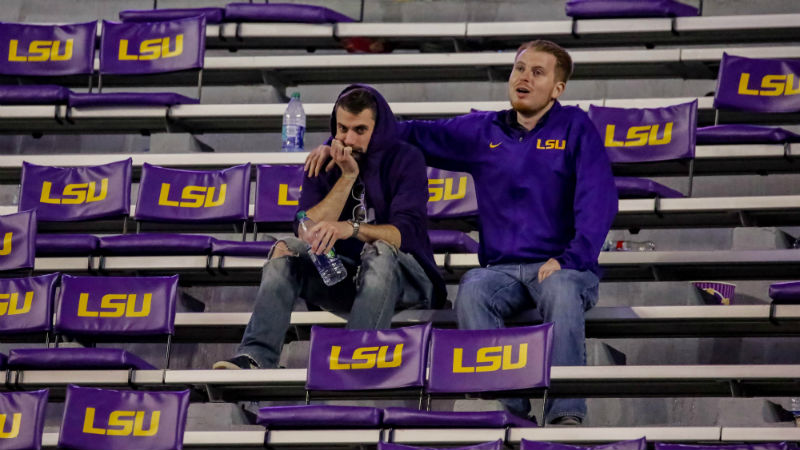
Derick E. Hingle-USA TODAY Sports. Pictured: Two sad LSU fans during the Tigers’ 29-0 loss to Alabama in 2018.
Sometimes the best thing we can do here at The Action Network is help you decide what not to bet on.
Today, it’s home underdogs in college football. I’m not telling you to never bet them — far from it. They cover at a 48.5% rate, so there will be literally hundreds of home dogs that cover this year. I just wanted to lay out our data from Bet Labs that shows home underdogs have been overvalued over the last 15 years, especially when compared to visiting underdogs, which have been a much better blind bet.
There will be lots of people across the Internet this fall giving you betting advice tied to raucous home crowds and hostile environments. It’s an easy thing to get swept up in, and an example of confirmation bias. You visualize Team A running out behind its home crowd, forcing a false start on the first drive, and you can’t get that picture out of your head. You think the price is right, and you bet them.
I’d argue that home-field advantage is overvalued in all sports from a betting perspective, and that most teams don’t deserve the traditional 3 points they’re given on the point spread in college football. Our Collin Wilson gives only 26 of 130 FBS teams at least 3 points.
Our data at Bet Labs indicates that blindly betting every college football road underdog since 2005 has been a much better idea than betting every home dog.
In general, visiting teams are better bets against the spread than home teams, though 2019 and 2020 were slightly better years for home teams.
All data from 2005-2019 unless otherwise noted. We’ll get into 2020 toward the end.
Against-the-spread records show that neither home or road dogs are blindly profitable, but visitors have been much better.
But what about on the moneyline? Surely, these frisky home dogs pull off upsets more often than they do on the road behind those raucous crowds. Maybe it’s a boom-or-bust thing — win outright or lose and don’t cover.
Negative.
Home underdogs on the moneyline have resulted in big losses for bettors. Visiting dogs have been much better.
Okay, but what if the spread is single digits? Surely if the game is expected to be close, the student section will help drown out the visiting quarterback’s orders and cause a false start in a key moment.
It’s actually been profitable to blindly bet single-digit underdogs on the road, both against the spread and on the moneyline. Not home underdogs.
It’s also worth looking at the last few seasons, since this data goes back to 2005 and college football has changed a lot. The last two years have been better for home underdogs, but over the last five year it’s still all about the road dogs.
Last year, the betting market actually overrated road teams, probably due to lack of crowds. Single-digit home dogs went 67-63-3 in 2020, good for a 0.3% ROI and .37 units. Small victories.
But it’s hard to take any macro trends away from the strangest college football season in our lifetimes.
There are ways to make a home underdog trend or system work — cherry picking conferences or weekday games, for example — but it’s mostly noise.
So tread cautiously, because as we get into conference play, the narrative train will only gain more steam.